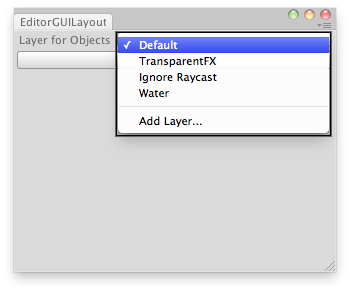EditorGUILayout.LayerField
切换到手册public static int LayerField
(int layer,
params GUILayoutOption[] options);
public static int LayerField
(string label,
int layer,
params GUILayoutOption[] options);
public static int LayerField
(string label,
int layer,
GUIStyle style,
params GUILayoutOption[] options);
public static int LayerField
(GUIContent label,
int layer,
GUIStyle style,
params GUILayoutOption[] options);
参数
| label | (可选)字段前的标签。 |
| layer | 字段中显示的层。 |
| style | 可选 GUIStyle。 |
| options | 一个可选的布局选项列表,用于指定额外的布局属性。此处传递的任何值都将覆盖 style 定义的设置。另请参阅:GUILayout.Width、GUILayout.Height、GUILayout.MinWidth、GUILayout.MaxWidth、GUILayout.MinHeight、 GUILayout.MaxHeight、GUILayout.ExpandWidth、GUILayout.ExpandHeight。 |
返回
int 用户选择的层。
描述
创建一个层选择字段。

设置所选游戏对象的层。
// Simple editor script that lets you set the layer for the // selected GameObjects.
using UnityEngine; using UnityEditor;
public class LayerFieldExample : EditorWindow { static int selectedLayer = 0;
[MenuItem("Examples/Layer Field usage")] static void Init() { LayerFieldExample window = (LayerFieldExample)GetWindow(typeof(LayerFieldExample)); window.Show(); }
// Disable menu if we dont have at least 1 gameobject selected [MenuItem("Examples/Layer Field usage", true)] static bool ValidateSelection() { return Selection.activeGameObject != null; }
void OnGUI() { selectedLayer = EditorGUILayout.LayerField("Layer for Objects:", selectedLayer); if (GUILayout.Button("Set Layer!")) SetLayer(); }
static void SetLayer() { foreach (var go in Selection.gameObjects) go.layer = selectedLayer; } }
Copyright © 2023 Unity Technologies
优美缔软件(上海)有限公司 版权所有
"Unity"、Unity 徽标及其他 Unity 商标是 Unity Technologies 或其附属机构在美国及其他地区的商标或注册商标。其他名称或品牌是其各自所有者的商标。
公安部备案号:
31010902002961